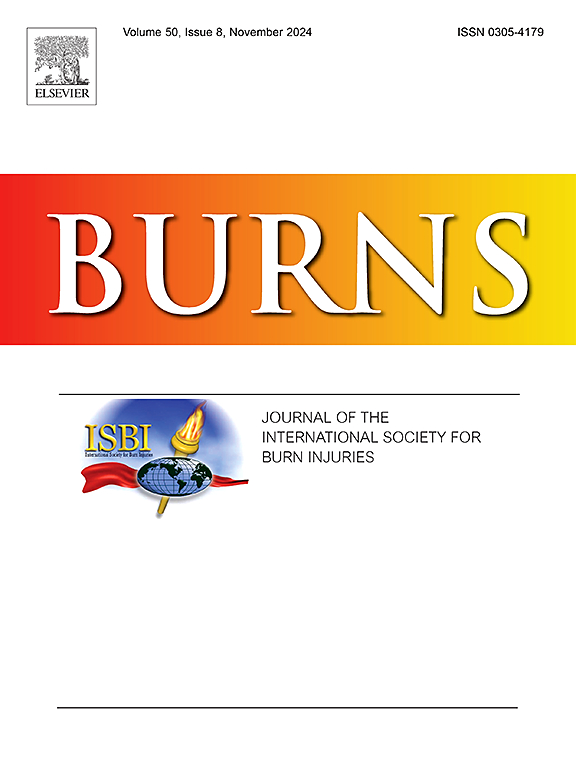尼泊尔严重烧伤成人肠内与静脉内复苏随机对照试验的可行性
IF 3.2
3区 医学
Q2 CRITICAL CARE MEDICINE
引用次数: 0
摘要
肠内复苏(EResus)安全、有效,具有操作优势,特别是在资源匮乏的情况下。然而,缺乏现实世界的有效性研究和基于证据的协议,这阻碍了实施。为了解决这一差距,我们在尼泊尔一家三级烧伤中心进行了一项肠内复苏与常规复苏的随机对照试验(RCT)之前进行了可行性研究,该中心此前没有临床试验经验。我们的目的是评估在这种情况下开展合作和前瞻性临床研究的可行性,干预的可接受性,以及对复苏和研究方案的依从性。方法:我们招募并随机分组30名受试者。我们通过复苏流程(n = 30)收集了参与者的定量和定性数据,并在复苏前后与参与者(n = 12)和提供者(n = 45)进行了深入访谈。通过对招募效率、方案依从性、数据收集准确性、高患者同意率以及通过对参与者和提供者的深入访谈收集的详细反馈进行系统评估,确定并描述了按照设计进行试验的能力、干预的可接受性以及对研究和复苏方案的依从性的证据。结果:我们通过维持每周的学习会议、实时WhatsApp通信以及为尼泊尔的可持续基础设施发展提供资金,展示了成功的研究合作。562例烧伤患者的筛选产生33名符合条件的参与者,接受率高,30人同意入组(91% %同意率)。该试验实现了复苏方案的高保真度,93% %遵守规定的肠内复苏容量。在研究期间,没有参与者退出,这表明了很强的保留性和协议依从性。结论:本研究确定了在没有先前试验经验的低资源背景下进行随机试验的可行性。肠内复苏是一种可接受和受欢迎的干预措施,登记率高。医院工作人员能够高保真地遵循研究和复苏方案,尽管需要进行一些优化。有了这些可行性证据,该试验将继续招募,未来的数据可能为在低资源环境中推进烧伤复苏提供有价值的见解。本文章由计算机程序翻译,如有差异,请以英文原文为准。
Feasibility of a randomized controlled trial of enteral vs intravenous resuscitation for adults with major burn injuries in Nepal
Introduction
Enterally-based resuscitation (EResus) is safe, efficacious, and has operational advantages, particularly in low-resource settings. However, there is a lack of real-world effectiveness studies and evidence-based protocols, which hinders implementation. To address this gap, we conducted a feasibility study ahead of a randomized controlled trial (RCT) of enterally based versus usual resuscitation at a tertiary burn center in Nepal which had no prior clinical trial experience. We aimed to assess the feasibility of conducting collaborative and prospective clinical research in this setting, the acceptability of the intervention, and compliance with the resuscitation and study protocols.
Methods
We enrolled and randomized 30 participants. We collected quantitative and qualitative data from participants via resuscitation flowsheets (n = 30), along with in-depth interviews conducted before and after resuscitations with participants (n = 12) and providers (n = 45). Evidence of the capabilities to perform the trial as designed, the acceptability of the intervention, and compliance with the study and resuscitation protocols was identified and described through systematic evaluations of recruitment efficiency, protocol adherence, data collection accuracy, high patient consent rates, and detailed feedback collected through in-depth interviews with participants and providers.
Results
We demonstrated successful research collaboration through the maintenance of weekly study meetings, real-time WhatsApp communication, and funding that allowed for sustainable infrastructure development in Nepal. Screening of 562 burn patients resulted in 33 eligible participants, with a high acceptance rate, as 30 consented to enroll (91 % consent rate). The trial achieved high fidelity in resuscitation protocols, with 93 % adherence to the prescribed enteral resuscitation volumes. No participant dropped out during the study period, indicating strong retention and protocol adherence.
Conclusion
This study established the feasibility of performing a randomized trial in a low-resource context with no prior trial experience. Enterally-based resuscitation is an acceptable and favored intervention with a high rate of enrollment. Hospital staff were able to follow the study and resuscitation protocols with high fidelity, though some optimization was requested. With this evidence of feasibility, the trial will continue enrollment, and the future data may provide valuable insights for advancing burn resuscitation in low-resource settings.
求助全文
通过发布文献求助,成功后即可免费获取论文全文。
去求助
来源期刊

Burns
医学-皮肤病学
CiteScore
4.50
自引率
18.50%
发文量
304
审稿时长
72 days
期刊介绍:
Burns aims to foster the exchange of information among all engaged in preventing and treating the effects of burns. The journal focuses on clinical, scientific and social aspects of these injuries and covers the prevention of the injury, the epidemiology of such injuries and all aspects of treatment including development of new techniques and technologies and verification of existing ones. Regular features include clinical and scientific papers, state of the art reviews and descriptions of burn-care in practice.
Topics covered by Burns include: the effects of smoke on man and animals, their tissues and cells; the responses to and treatment of patients and animals with chemical injuries to the skin; the biological and clinical effects of cold injuries; surgical techniques which are, or may be relevant to the treatment of burned patients during the acute or reconstructive phase following injury; well controlled laboratory studies of the effectiveness of anti-microbial agents on infection and new materials on scarring and healing; inflammatory responses to injury, effectiveness of related agents and other compounds used to modify the physiological and cellular responses to the injury; experimental studies of burns and the outcome of burn wound healing; regenerative medicine concerning the skin.
 求助内容:
求助内容: 应助结果提醒方式:
应助结果提醒方式:


